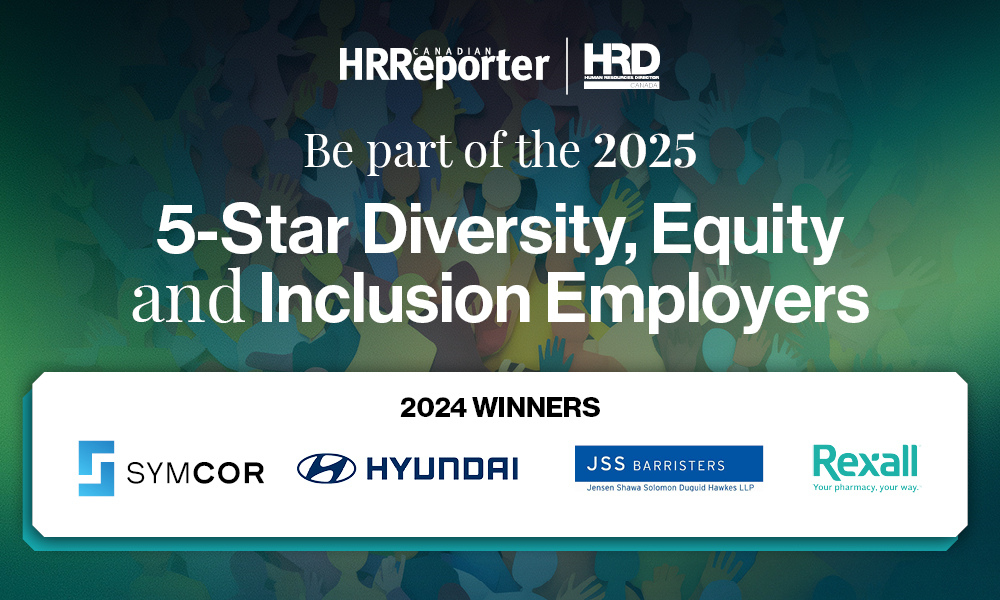Winner, Rideau Best Recognition Program
There are many organizations where the strategic benefits of employee recognition go sadly unrecognized. But ATB Financial isn’t one of them.
The Alberta-based financial services provider, which has 4,674 full-time employees, has the aspiration of being the best place to work — not just in Alberta, but anywhere, says Lorne Rubis, the organization’s Edmonton-based chief people officer.
“Part of that… we knew would always be the notion of recognition in our business. And the reason we felt that way is we needed to have a platform for leaders to identify the type of behaviour that they valued, and give them an opportunity to publicly and openly acknowledge that,” he says.
To do so, ATB uses a social, mobile recognition platform it has branded “Everyday Heroes.”
Timely, social recognition
Using a timely, engaging recognition platform is something that was particularly important to Rubis. So when he arrived at ATB, he was pleased to see the organization was already in the process of looking into more social, intuitive recognition platforms.
The Everyday Heroes platform allows for extremely timely recognition, says Jodi Montalvo, senior specialist, talent development, based in Calgary. And that is one key reason why ATB has seen huge growth in how recognition has become such a driver of the culture.
The platform has a familiar setup to some popular social media sites, says Montalvo.
“If you can imagine almost a Facebook-type idea with a news feed, that’s similar to what it looks like to some degree. And as a company, we can choose what types of values we want to recognize… and so we have 10 ‘ATBs,’ and those are what we recognize for,” she says. “That’s part of the reason why it’s such a driver of our culture — it just reinforces the behaviours that are important to us.”
Everyday Heroes compiles all of the recognition sent and received into a public, social news feed, says Nichole Geleta, project co-ordinator, talent and development, based in Calgary.
“People can go in and they have the option to ‘boost’ recognitions and also comment on things,” she said, adding that “boosting” is similar to the “Like” function found on Facebook.
The platform is also very mobile and user-friendly, says Rubis. “You can do it from any device anywhere.”
He sends out about 30 recognitions a month — but they’re easy to fit into a hectic schedule.
“I do most of those recognitions while I’m moving — I’m waiting for a plane, I’m in a taxi, and I’ve got a moment to just reflect on the day or the moment, and acknowledge someone,” he says.
Rising through the ranks
In concert with the everyday peer-to-peer recognition ATB offers, there are other levels of recognition for employees.
The “next level” up from everyday recognition is points-based recognition, says Geleta. Each month, every employee is allocated a certain amount of points to give out.
Employees have access to a catalogue of rewards they can purchase with those points, says Rubis.
“If you’ve got someone… who’s had their eye on a mini iPad or a weekend away somewhere, they (can) accumulate those points and put it to work for themselves,” he says.
“The primary driver, though, is the cultural driver around waking up and thinking intentionally around how you will see behaviour that you want to acknowledge and recognize.”
The next level up is the quarterly awards, which anyone can be nominated for, says Montalvo. At the end of each quarter, the leadership group selects the award- winners. About eight per cent of ATB’s employees win each quarter, she says.
Quarterly winners receive a certificate, as well as a celebration of some sort, says Geleta.
“Each of our different areas have different ways of doing that. Some do lunches, some do dinners, some podcast and broadcast it… some do surprise marching bands. It’s really anything goes,” she said, adding that there is a lot of room for creativity and fun.
In one instance, a quarterly award-winner’s family even got in on the celebration, says Geleta.
“They had her children videotape why they think their mom is so awesome, and then showed that in a meeting — kind of impromptu — and said, ‘Congratulations, this is what your kids had to say,’” she says.
The highest honour the organization hands out is the President’s League award. Winners are selected from the pool of quarterly award-winners and included in a special gala weekend experience, says Geleta.
The President’s League awards are won by about one-and-a-half per cent of ATB’s employees and handed out annually, says Montalvo.
“That President’s League award is our sort of pinnacle award — top of the top, best of the best.”
Employee uptake, metrics
Years ago, before ATB rolled out the Everyday Heroes platform, the recognition program was under-utilized and people weren’t really aware of it, says Geleta. But when the new program launched in July of 2012, it saw a huge uptake from employees.
“I think people just really liked the fact that they were empowered to send the recognitions themselves, whereas before it was always coming down from leadership,” she says. “It really took off.”
In terms of employee communications, ATB hasn’t found a need for a lot of promotion around the platform, says Rubis — with the exception of special, time-based campaigns.
“One of the reasons is that it’s so easy,” he says. “It gives people a reason to (participate).”
In fact, employee participation is near 100 per cent, says Montalvo — the activation is over 99 per cent.
The platform also provides rich, detailed data for HR, says Rubis.
“Because it’s a digital-based platform, it’s very rich in reporting. So you know exactly how many recognitions have been given, who’s been giving the most recognitions, and then we have an analytics team that looks at recognitions more completely, so we look at linkages to engagement,” he says. “You also can run other kinds of reports… it’s all really a click away.”
HR makes the data available throughout the organization, and particularly to people managers who might want the information for performance conversations, says Montalvo.
“We do a quarterly report to the organization as a whole, so… we break it down for each group and provide that quarterly,” she says.
“However, the data can be sliced just about any way you can think of, and provided at any time.”
Each people manager has the ability to go in and look at data live, she says.
“As a leader, you can break it down and you can really talk about that in a fulsome way when you’re having a performance conversation.”
One of the most important aspects of the recognition program is its strategic value and positive impact on the culture, says Rubis.
“Beyond just a recognition program — which was very important in its own right — we realized we had a storytelling platform. And it’s a way for people to tell a story about the actions of others that they want to applaud and recognize,” he says.
“Those elements together just made us realize that this is a vital investment and a key platform around our overall strategy of being the place to work.”
Not every organization recognizes the strategic importance of a strong recognition program, says Rubis — and they are missing out.
“Less-informed organizations think of (recognition) as a, ‘atta-girl, ‘atta-boy’ kind of initiative — something that mushy people in HR do. We don’t think about it that way at all. This is a strategic, cultural business driver that reinforces who we are at ATB, and we see it as an opportunity to create and tell a story.”




